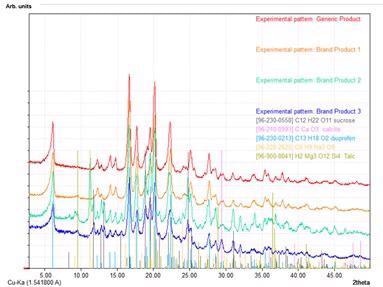A wide range of organic compounds are used as APIs (active pharmaceutical ingredients) in the pharmaceutical industry and for applications like dyes or foods. These compounds typically consist of light elements such as carbon or nitrogen.
There are specific requirements for quality control, primarily due to APIs’ direct administration to humans as part of health treatments.
Organic compounds typically exhibit minimal absorption of X-rays due to their low density. It is possible, however, to use appropriate transmission diffraction techniques for data acquisition.
Transmission diffraction techniques offer a number of advantages over reflection measurements.
Reflection measurements result in a high penetration depth of X-rays due to the weak absorption of organics. This has a negative impact on a measurement’s position accuracy and resolution.
The crystallographic structure of a range of organic compounds shows strong preferred orientation effects in reflection. This effect can be minimized via the use of transmission diffraction techniques.

Preferred orientation in reflection measurements has a strong influence on intensities; Intensities in reflection do not match reference card date (blue sticks) while positions are unaffected. Image Credit: Thermo Fisher Scientific – Materials & Structural Analysis
Polymorphism in crystallography sees a molecule’s solid chemical form existing in more than one crystalline structure. These forms differ to a degree in terms of their physical and chemical properties, though their vapors and solutions remain identical.
This phenomenon has a notable impact on APIs, which may exhibit differing physiological effects between polymorphs. It is, therefore, important to identify and manage the polymorphic composition of APIs in pharmaceutical formulations.
XRD remains the gold standard for the determination of polymorphism due to its sensitivity to differences in the crystallographic structure.

XRD pattern of Rimonabant Polymorphs I and II. Image Credit: Thermo Fisher Scientific – Materials & Structural Analysis
Scientists and quality control managers require compliant, convenient tools to analyze materials. The ARL™ EQUINOX X-ray Diffractometers from Thermo Scientific™ offer rapid data collection versus a range of other options.
This is due to its distinct, curved position sensitive (CPS) detector’s capacity to measure all diffraction peaks simultaneously and in real-time.
The instrument’s rugged design and its use of X-ray optics make it ideally suited for measurements in both transmission and reflection. The Thermo Scientific™ SolstiX XRD software suite is also 21 CFR 11 ready, allowing users to easily and conveniently meet their compliance requirements.
The ARL™ EQUINOX 100 benchtop diffractometer allows researchers to effectively ascertain the quality of pharmaceutical formulations in under 10 minutes using transmission mode – an essential consideration in both research labs and during the production process.
The instrument features a powerful high flux X-ray source with very low power consumption – the most energy-efficient XRD solution available due to its ability to operate without an external water chiller or other peripheral equipment.

Analysis of several Ibuprofen formulations in transmission mode (EQUINOX 100). Image Credit: Thermo Fisher Scientific – Materials & Structural Analysis
The ARL™ EQUINOX includes a range of convenient and flexible solutions for organic samples and is suitable for use in both compliant and non-compliant environments.
Even inexperienced or new users can switch measurement modes in a matter of seconds, enabling rapid, streamlined measurement.
Acknowledgments
Produced from materials originally authored by Dr. Simon Welzmiller from Thermo Scientific.

This information has been sourced, reviewed and adapted from materials provided by Thermo Fisher Scientific – Materials & Structural Analysis.
For more information on this source, please visit Thermo Fisher Scientific – Materials & Structural Analysis.